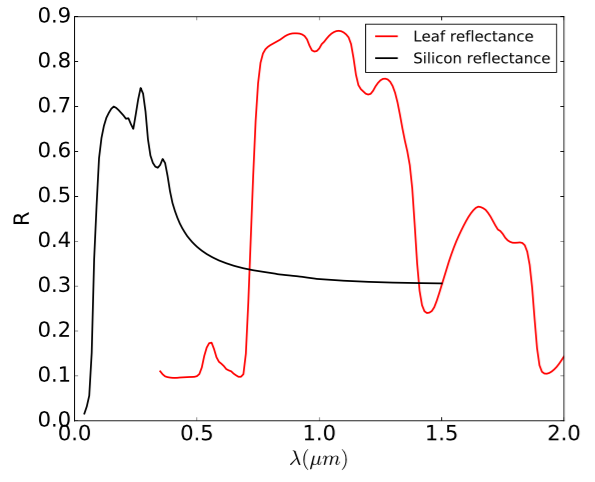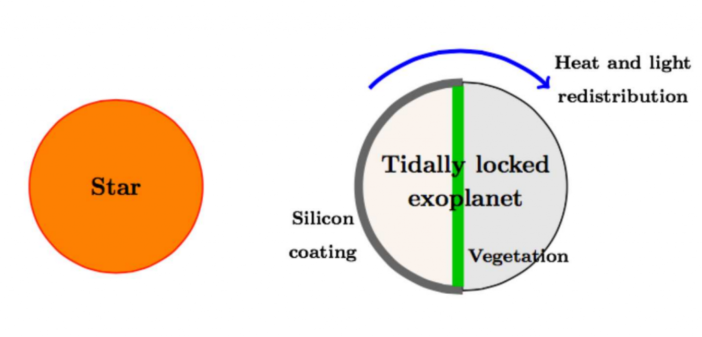Editor’s note: Astrobites is a graduate-student-run organization that digests astrophysical literature for undergraduate students. As part of the partnership between the AAS and astrobites, we repost astrobites content here at AAS Nova once a week. We hope you enjoy this post from astrobites; the original can be viewed at astrobites.org!
Title: Natural and Artificial Spectral Edges in Exoplanets
Authors: Manasvi Lingam, Abraham Loeb
First Author’s Institution: Harvard-Smithsonian Center for Astrophysics
Status: Submitted to ApJL, open access
The explosion in the number of discovered exoplanets — especially some interesting systems with terrestrial planets in the habitable zone — has attracted a lot of attention. We are moving one step closer to the ultimate question: are we alone? Today’s paper looks at certain distinctive spectral features that could be caused by “extraterrestrial plants”, or even crazier: advanced civilizations.
The Sky Is Blue and All the Leaves Are Green
Ever wondered why most plants look green? The first answer you might get is because of chlorophyll, the green pigments responsible for photosynthesis. Plants carry out photosynthesis to convert water and CO2 into sugar and oxygen, using energy from the Sun. But one might further ask: why is chlorophyll green? Well, chlorophyll absorbs light primarily in the range from ~450 nm (blue) to ~650 nm (red). It operates in the visible spectrum range but is not as efficient in green light. So in visible light, the photons at green wavelength are reflected the most, producing the color that we see. This causes the small bump of the leaf reflectance near 500 nm (0.5 μm) in Figure 1. Note the sharp jump of reflectance starting around 0.7 μm and going into the infrared. This so-called “red edge” can be a useful feature for detecting vegetation on planets, since few substances in nature have such high reflectivity in that wavelength range. The strength of the red-edge feature is used on Earth to monitor the growth of vegetation (such as crops). Imagine if our eyes were a little more sensitive toward red; we would see the world very differently with plants turning red (and much brighter)!

Figure 1. The reflectance R for silicon-based solar cells (black) and plants (red), shown as a function of wavelength λ. The peaks in the reflectivity in the UV region of silicon and at 0.7 μm of plants are the distinct “spectral edges”. [Lingam & Loeb 2017]
We Need More Energy!
In today’s paper, the authors also boldly explore the possible “artificial spectral edges” — that is, advanced civilizations modifying the planet surface such that it changes the observable spectra as well. It is conceivable to assume that advanced civilizations would come up with a method to handle energy crises. One possible way is to harness a significant amount of energy from the star by constructing large arrays of solar cells. This is particularly relevant for tidally-locked planets around M-stars, such as Proxima b, where the dayside is permanently illuminated. The solar cells are made of semiconductors (typically silicon), which have an energy gap between the valence band and the conduction band. Photons with energies less than the band gap are scattered, causing high reflectance, similar to plants but at a shorter wavelength in UV. The authors explored a hypothetical scenario in which planets are covered with mega-scale arrays of solar cells, showing the reflectance for silicon-based solar cells in Figure 1.

Figure 2. Schematic illustration of terraforming on tidally locked exoplanets. Photovoltaic arrays on the day side are used to harness stellar energy, which is redistributed as heat and light on the night side. [Lingam & Loeb 2017]
Of course, this is not saying we are going to find extraterrestrial life tomorrow, but it is helpful to keep in mind the possible information hidden in the reflected light. After all, the last thing we want is to see the sign, yet miss it.
About the author, Shang-Min Tsai:
I am a 3rd year PhD student at the University of Bern and part of the Exoplanets & Exoclimes Group led by Prof. Kevin Heng. We are developing various open-source tools to study exoplanets. I work on modelling of atmospheric chemistry and dynamics. When I am not coding or debugging, I enjoy basketball and playing board games.

6 Comments
Pingback: The Grass Might Be Redder on the Other Side – MeasurementDataBases for Industry & Science
Pingback: searching for life spectroscopically
Pingback: The Grass Might Be Redder on the Other Side – New
Pingback: Идеальный мир: почему Земля - не самое лучшее место для жизни | INFOS.BY
Pingback: Идеальный мир: почему Земля — не самое лучшее место для жизни — Коммуника
Pingback: Почему Земля - не самое лучшее место для жизни: идеальный мир | INFOS.BY